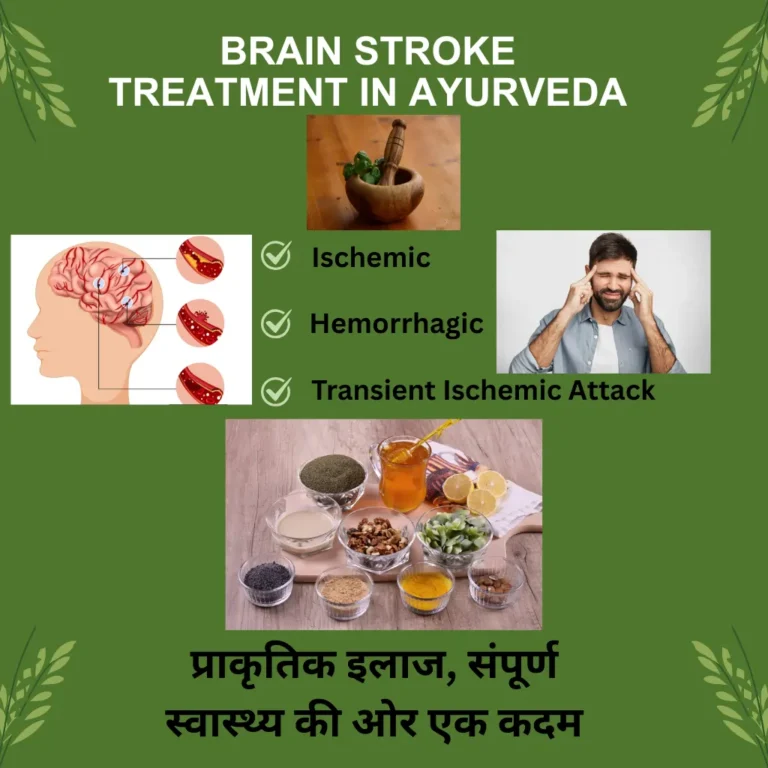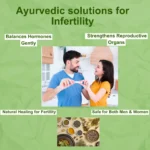Brain Stroke Treatment in Ayurveda: A Natural Healing Guide
Introduction:
Imagine this: You’re enjoying a peaceful moment with your family. Suddenly, your loved one can’t speak, their face droops, or their arm goes numb. In a matter of seconds, your world turns upside down. That’s how a brain stroke strikes—fast and without warning. Brain stroke treatment in Ayurveda offers a natural and holistic path to healing after such an event. Ayurveda, India’s ancient system of medicine, has helped people recover from serious conditions like stroke for thousands of years.
In this blog, we will explore everything you need to know about brain stroke, its types, causes, symptoms, and risk factors. Most importantly, you’ll discover how Ayurvedic therapies, herbs, diet, and lifestyle changes can naturally support healing and recovery.
Let’s begin this journey with clarity and compassion.
What is a Brain Stroke?
A brain stroke is a medical emergency where blood flow to a part of the brain is cut off or reduced. When the brain doesn’t get enough oxygen and nutrients, brain cells begin to die within minutes. This can lead to permanent brain damage or even death.
In Ayurveda, a stroke is referred to as “Pakshaghata”. It is described as a condition caused by the vitiation of Vata dosha, which governs movement and neurological functions.
Learn more about Ayurvedic Treatment for Headache
What Happens During a Stroke?
Your brain controls every part of your body. When a stroke occurs:
- Oxygen doesn’t reach the brain cells
- Cells start to die within minutes
- Messages from the brain stop going to the rest of the body
- This can lead to paralysis, speech problems, and loss of memory or function
Early action can limit the damage and save lives.
Types of Brain Stroke
Strokes are mainly divided into three primary types, based on the cause of disrupted blood flow:
1. Transient Ischemic Attack (TIA)
Also called a “mini-stroke.”
- Caused by a temporary blockage
- Symptoms last for a few minutes or hours
- No permanent damage but a warning sign for future strokes
2. Ischemic Stroke
Most common type (about 87% of strokes)
- Occurs when a blood clot blocks a brain artery
- Leads to brain cell death due to lack of oxygen
3. Hemorrhagic Stroke
Less common but more severe
- Caused by a ruptured blood vessel in the brain
- Blood leaks into the brain, causing pressure and damage
Subtypes of Stroke
Strokes are further classified depending on how and where they occur:
A. Embolic Stroke
- Blood clot or debris from another part of the body travels to the brain
B. Thrombotic Stroke
- Blood clot forms in an artery supplying blood to the brain
C. Subarachnoid Hemorrhage
- Bleeding between the brain and the thin tissue covering it
- Usually caused by a burst aneurysm
D. Intracerebral Hemorrhage
- Bleeding within the brain tissue itself
- Often caused by high blood pressure
Understanding the type of stroke is important because treatment varies accordingly.
Symptoms of Stroke
Stroke symptoms appear suddenly. They can include:
| Symptom | Description |
|---|---|
| Face drooping | One side of the face looks uneven or numb |
| Arm weakness | One arm cannot be lifted or feels heavy |
| Speech difficulty | Slurred or unclear speech |
| Vision trouble | Sudden blurry or double vision |
| Balance problems | Dizziness or loss of coordination |
| Headache | Sudden, severe headache with no known cause |
| Numbness | Especially on one side of the body |
Use the acronym F.A.S.T.:
- Face drooping
- Arm weakness
- Speech difficulty
- Time to call emergency services
When to See a Doctor
Time is brain. If you see stroke symptoms, don’t wait. Seek immediate medical help:
- If the symptoms last more than a few minutes
- If there’s a history of TIA or heart disease
- If someone suddenly becomes unresponsive or confused
Early treatment can reduce damage and save lives.
Stroke is often linked to underlying health and lifestyle problems. Here are the key risk factors:
Lifestyle Factors:
- Smoking
- Excess alcohol
- Poor diet (high in salt, fat, and sugar)
- Lack of exercise
- Obesity
- Chronic stress
Medical Conditions:
| Condition | Risk |
| High blood pressure | Damages blood vessels in the brain |
| Diabetes | Affects blood flow and increases clot risk |
| High cholesterol | Leads to fatty buildup in arteries |
| Heart disease | Can send clots to the brain |
| Sleep apnea | Causes drops in oxygen supply to the brain |
Unchangeable Risk Factors:
- Age (risk increases after 55)
- Male gender (slightly higher risk)
- Family history of stroke
- Previous stroke or TIA
Ayurvedic Approach to Stroke (Pakshaghata)
In Ayurveda, stroke is seen as a disorder of Vata dosha, which governs all movement in the body, including the flow of nerve impulses and blood. When Vata gets imbalanced, it can lead to blockages, paralysis, or loss of motor control.
Ayurvedic treatment aims to:
- Restore Vata balance
- Nourish brain and nerve tissues
- Clear toxins (Ama)
- Promote healthy circulation
- Support natural recovery and regeneration
Ayurvedic Therapies for Stroke Recovery
1. Abhyanga (Herbal Oil Massage)
- Uses medicated oils like Bala Taila or Ashwagandha oil
- Stimulates nerves, improves circulation, reduces stiffness
2. Swedana (Herbal Steam Therapy)
- Opens blocked channels
- Reduces muscle stiffness and increases flexibility
3. Nasya (Nasal Therapy)
- Application of herbal oils through nostrils
- Clears head region and nourishes brain cells
4. Basti (Medicated Enema)
- Best therapy for balancing Vata
- Removes toxins, improves bowel function, and supports nerves
5. Shirodhara
- Warm oil is poured gently on the forehead
- Calms the mind and improves sleep and brain function
Ayurvedic Herbs for Brain Stroke
| Herb | Benefits |
| Ashwagandha | Calms nervous system, reduces stress |
| Brahmi | Enhances memory and brain function |
| Shankhpushpi | Reduces anxiety, improves focus |
| Vacha | Aids speech recovery and clears mind |
| Guduchi (Giloy) | Boosts immunity, reduces inflammation |
| Bala | Strengthens muscles and nerves |
| Haritaki | Supports detoxification and digestion |
These herbs are usually given in combination, in the form of powders, oils, or decoctions.
Discover more about Giloy and Its Benefits
Diet and Lifestyle for Stroke Recovery
Ayurveda emphasizes the importance of proper food and routine for healing.
Recommended Foods:
- Warm, fresh, and easy-to-digest meals
- Moong dal, rice, boiled vegetables
- Ghee and olive oil in small amounts
- Herbal teas with ginger, tulsi, or cinnamon
Foods to Avoid:
- Cold, raw, or processed foods
- Fried and heavy meals
- Sugar and sugary drinks
- Alcohol and caffeine
Lifestyle Tips:
- Practice gentle yoga and meditation
- Get regular sleep
- Avoid screen time at night
- Follow a daily routine (Dinacharya)
- Surround yourself with positivity
Key Takeaways
- A stroke is a sudden stoppage of blood flow to the brain, causing serious damage
- Major types: TIA, Ischemic, and Hemorrhagic strokes
- Stroke is often linked to Vata imbalance in Ayurveda
- Ayurvedic therapies like Abhyanga, Basti, and Nasya aid recovery
- Herbs like Brahmi, Ashwagandha, and Bala support nerve health
- Right diet and lifestyle are key to healing and prevention
Conclusion: The Ayurvedic Way Forward
A stroke can be frightening, but it doesn’t have to define your future. Ayurveda gives you hope—a natural, gentle, and time-tested path to recovery.
Whether it’s through herbal remedies, special therapies, or simple lifestyle changes, the Ayurvedic approach aims to heal not just the body but the mind and spirit. Start your healing journey today, and let Ayurveda guide you back to balance and wellness.
Remember, healing is a process. With patience, love, and nature’s help, recovery is not just possible—it’s powerful.
FAQs
Ayurveda helps manage symptoms and support natural recovery. It is not a replacement for emergency care but works well in long-term recovery.
It depends on the severity of the stroke. Many patients show improvement over weeks to months with consistent treatment.
Yes, but under the guidance of both Ayurvedic and allopathic doctors.
Yes. By balancing Vata, maintaining a healthy lifestyle, and managing stress, the risk can be reduced.
Ayurveda helps manage symptoms and support natural recovery. It is not a replacement for emergency care but works well in long-term recovery.
It depends on the severity of the stroke. Many patients show improvement over weeks to months with consistent treatment.
Yes, but under the guidance of both Ayurvedic and allopathic doctors.
Yes. By balancing Vata, maintaining a healthy lifestyle, and managing stress, the risk can be reduced.


